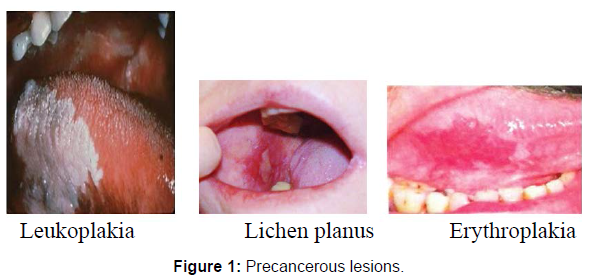Oral Cancer: Why You Need to Take Care of Your Teeth & Mouth
Received: 20-Feb-2022 / Manuscript No. roa-22-55028 / Editor assigned: 22-Feb-2022 / PreQC No. roa-22-55028(PQ) / Reviewed: 08-Mar-2022 / QC No. roa-22- 55028 / Revised: 14-Mar-2022 / Manuscript No. roa-22-55028(R) / Published Date: 21-Mar-2022 DOI: 10.4172/2167-7964.1000365
Introduction
Oral cancer is the most prevalent cancer among males and the third most common carcinoma among women in India, and it is a serious public health problem. Oral cancer is one of the most common cancers in India, accounting for four out of ten cases. The use of tobacco in two forms, smoked and smokeless tobacco, has long been related to a high prevalence of oral premalignant lesions and oral cancer. Data on the usage of tobacco in the type of cigarettes, cigars, bidis, and pipes appears to be significantly more abundant. As per case control research done in India, males who chewed tobacco had a 6 times greater risk of developing mouth cancer than non-chewers.
The risk for women that had never consumed tobacco was 46 times higher than for females who had never consumed tobacco.
Oral cancer might manifest itself in one of three ways [1].
• The lips.
• The oral cavity, consisting includes: • The tongue’s anterior two-thirds.
• Ginkgo Biloba (gums).
• Buccal mucosa (both lining of inside the cheek). • Mouth floor (below the tongue).
• Sensitive taste buds (the roof of the mouth).
• Trigone retromolar.
Oropharynx
• The Posterior One-Third of the Tongue,
• The Middle Portion of the Pharynx (Throat) and
• The Middle Section of the Pharyngeal (Throat) Behind the Mouth.
• Tonsils Soft Palate Side and Rear Sides of the Throat
Oral cancer risk factors
Tobacco usage is among the biggest avoidable causes of mortality globally. Smoking is more likely to cause laryngeal cancer than mouth cancer. Smoking plates are thought to be the most significant risk factor for mouth cancer. Probably a blend of areca nuts, salted lime, and tobacco. Certain health conditions, such as alcohol consumption and exposure to radiation, have a synergistic influence on the formation of oral cancer. These correlations, however, will not be as strong as cigarette usage.
Oral cancer diagnosis Aids and tests [2].
Chair side adjuncts and tests include light-based detection technologies, fluorescence, VizLite, VELscope, and brush cytology. Saliva testing advancements are also yielding promising preliminary findings.
Precancerous lesions include [3-5].
• Leukoplakia which is any whitish patch or plaque on the mucosa which can be scrapped off can be attributable to every diagnosable condition except tobacco use.
• Erythroplakia is a clinical word that refers to any erythematous (red) spot on a mucosal membrane. Palatal alterations in reverse smokers (Smoker’s Palate) the following are the Precancerous Conditions:
• Sub mucous Fibrosis of the Oral Mucosa.
• Lichen planus of the Oral Mucosa (Figure 1).
Early Diagnosis and Prevention
Early Detection and Prevention are synonymous. In the case of cancer, prophylaxis and cure are identical. Cancer can only be cured if it is detected early and prevented. Because treatment for oral cancer in the form of surgery or radiation therapy induces many adverse side effects, particularly facial disfigurement, and has a long-term impact on the patient’s physical and mental health, there is a need to
• Increase research in areas of easy and initial credible diagnosing and diagnostic methods.
• Raise public awareness of the necessity of early detection.
• Educating health professionals, particularly dentists, about the detection and prevention of oral cancer.
• Do not use any sort of tobacco.
• Limit your alcohol consumption.
• Conduct your own investigation.
• Get an ordinary expert screening.
Conclusions
Cancer can be prevented by
• Recognising its causes and implications
• Reducing the risks connected with it.
• Recognising and controlling precancerous lesions.
• Making the earliest diagnosis and prescribing prompt and suitable therapy.
• Effective therapeutic complication management
References
- https://www.hopkinsmedicine.org/health/conditions-and-diseases/oral-cancer-and-tobacco#:~:text=Consider%20these%20facts%3A,esophageal%20cancer%2C%20and%20laryngeal%20cancer.
- Paul WF, Howard WF, Bruce HH, Marci ML, Valerie JL, et al. (2007) Cummings Otolaryngology: Head and Neck Surgery. 7th ed.
- Nikhil S, Bernard AC (2022) Paediatric Dermatology. 5th ed.
- Lojaine Saleh (2013) Textbook of Oral Medicine, Oral Diagnosis and Oral RadiologyOngole.
- ÇelebiS CR, Yörükan S (1999) Physiology of the Oral Cavity Oral Dis 7-14.
Citation: Jha N, Kumar R, Sachan P (2022) Oral Cancer: Why You Need to Take Care of Your Teeth & Mouth. OMICS J Radiol 11: 364. DOI: 10.4172/2167-7964.1000365
Copyright: © 2022 Jha N, et al. This is an open-access article distributed under the terms of the Creative Commons Attribution License, which permits unrestricted use, distribution, and reproduction in any medium, provided the original author and source are credited.
Select your language of interest to view the total content in your interested language
Share This Article
Open Access Journals
Article Tools
Article Usage
- Total views: 8987
- [From(publication date): 0-2022 - Dec 06, 2025]
- Breakdown by view type
- HTML page views: 8199
- PDF downloads: 788

